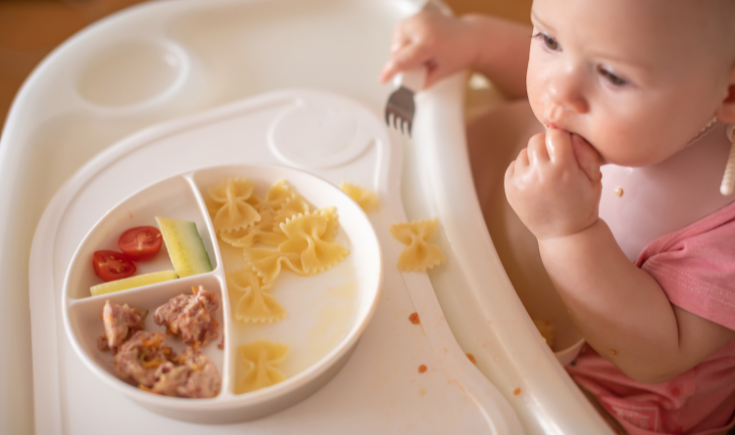

When it comes to feeding toddlers, let’s face it, mealtimes can be a struggle, particularly if you have a picky eater. With a constantly changing list of likes and dislikes, and their preference (or obsession!) for snacks, it’s a daily challenge to find creative ways to encourage them to eat a variety of foods.
You’ve probably tried every trick in the book, or admitted defeat and just continue to cook what you know they’ll eat. You’re definitely not alone!
However, if you’re looking for an innovative and unbelievably simple way to get your little one to get more adventurous around food, consider trying out a toddler tasting platter. In this post, we’ll explain what that is, the benefits of offering one, plus some tips to help and ideas to inspire you.
Toddler tasting platters: A mealtime strategy for success
What is a toddler tasting platter?
It’s simply a collection of small portions of foods that are arranged on a plate or platter. It’s designed to give toddlers a variety of options to choose from and explore, making it especially helpful for picky eaters.
The platter usually consists of nutritious items like fruits, vegetables, proteins, and grains. The idea is to provide a variety of textures and flavours that are appealing to the toddler.
What are the benefits of offering a tasting platter?
Here are 10 benefits of offering a tasting platter to your toddler, whether it’s as a stand-alone meal or alongside a family meal:
- Relaxed: They can explore the different items on the platter without feeling overwhelmed. Exploration could be with their hands, it could be a lick, a squish, or a taste. They’re all wins when it comes to food exploration and picky eating.
- Variety: They can try a little bit of each item and decide what they like and don’t like. This helps them become more adventurous eaters and encourages them to try new things.
- Exposure: The key to encouraging a child to try new things is exposure, exposure, exposure. Along with favourite items, you can add new foods over and over again so that they become familiar and less daunting.
- Interactive: They make mealtimes more engaging. Toddlers can be easily distracted and lose their appetite, so having a variety of items can help keep their attention. Add in some small tongs, and you’ll be sure to keep them at the table longer than usual.
- Enjoyable: You can get creative and arrange the items on the platter in different ways, which makes meal preparation more interesting.
- Economical: This approach uses up leftovers from previous meals or snacks, so there’s less waste. Plus, anything on the platter that’s untouched can be stored for the next platter.
- Simple: You can put together a tasting platter really quickly using up whatever you have. It’s often just a matter of heating or cutting up a few items. There’s no need to make special meals for them, either.
- Autonomy: We know toddlers love doing things for themselves so eating from a tasting platter without help or pressure satisfies that natural urge for independence. Get your toddler to help you prepare it for a bonus opportunity to be a part of the process and receive that wonderful sense of accomplishment.
- Calm: Your role is to prepare the tasting platter, and that’s it. You don’t have to feel frustrated and stressed that they’re refusing what you make, which often feels like you’re wasting your precious time. The rest is up to your child. How much they eat and whether they eat it at all is their responsibility. We can’t force someone to eat, and the idea is to keep mealtimes as stress-free as possible.
- Versatile: You don’t need to stick to a theme or put foods you think will work best together. For instance, you could add leftover roast pumpkin alongside some raspberries, olives, carrot sticks, and chickpeas. Don’t overthink it; it’s okay and even preferential to mix it up each time you offer it.
Tips and ideas for creating tempting toddler tasting platters:
Include a variety of colours and developmentally appropriate textures, such as crunchy vegetables, soft fruits, and other items like crackers and cheese.
- Keep it simple. Avoid adding too many different items to the platter. It can be overwhelming for toddlers and make the plate less appealing.
- Let your toddler help. Involving your toddler in the creation of the tasting platter can help make it more exciting and fun. Ask them to pick out some of their favourite items to add to the platter.
- Offer a dip. Adding a dip such as hummus or yogurt to the platter can make the meal more enticing and fun.
- Get creative. You don’t have to limit yourself to traditional snack items. Add items such as dinner leftovers and jarred or canned foods. Get creative and add mini pancakes, mini muffins, or mini sandwiches. Most of these you can make a large batch of and freeze. Here are some ideas here.























